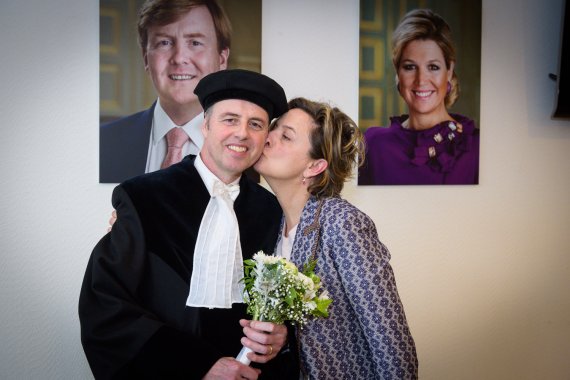Adriaan Geuze being congratulated by his wife. © Guy Ackermans
‘I am landscape architecture, I breathe landscape architecture.’ This is what Adriaan Geuze confides to the audience in the Aula before even starting his inaugural lecture. There is no doubt a passionate man has taken the stage.
Adriaan Geuze looks at the audience with slight amusement. His pitch is high, and he speaks with clear and delicate diction. He is wearing the old toga of Emeritus Professor and colleague landscape architect Meto Vroom, who is among the attendees. It was a gift from his old teacher. Geuze is visibly flattered. The Aula is nearly filled. It is a mixed party: family, colleagues, Dutch and international students, and quite a few well-known Dutch actors, among whom are Jacqueline Blom – Adriaan Geuze’s wife – and Pierre Bokma.
Handicap
The lecture is held in Dutch, which is so much of a handicap for some that they leave the Aula prematurely. Which is a shame, as Geuze’s story on the development of Dutch landscape is captivating. In his lecture, he effortlessly includes the Roman writer Pliny the Elder, the painter Jan van Scorel and the only Dutch Pope – Adrian VI. And this lecture is on the subject of typical developments in the landscape of the Netherlands.
People lived on the edge for centuries.
Adriaan Geuze, professor of Landscape Architecture
He does this using three perceptions of the landscape. The first is the euphoric feeling that the mound builders must have experienced some 2000 years ago: we can create land! The second perception is the fear of the early medieval Dutch, when the land was threatened by sinking soils and rising water levels. Direct action was required to prevent them from drowning. People lived on the edge for centuries.
Finally, the landscape was perceived as an object. Money can be made off it. In the XIV century, most of the land belonged to bishops and nobility. But colonists who fled the feudal world also exploited land, by extracting peat, for example. The locator makes his appearance – a project developer avant la lettre – who negotiates on behalf of various parties. These are three developments of the past that are still very actual for the Dutch landscape.
Adore it
According to Geuze, we identify with the landscape. He shows paintings from the XVII, XVIII and XIX centuries in which the Dutch landscape is idealised. We simply adore it. At the same time, however, there is an indomitable drive to change the landscape, transform it, tame it time and time again.
Adriaan Geuze glances at his watch. The sleeves of his toga are a bit long, forcing him to fully extend his arm before the dial appears. He then speaks his last word, ‘Dixit’.
Applause.
Led by the registrar, the cortège leaves the Aula. Professor Geuze is directed toward the reception hall. The long procession of guests is on its way. The grand shaking of hands can commence.

